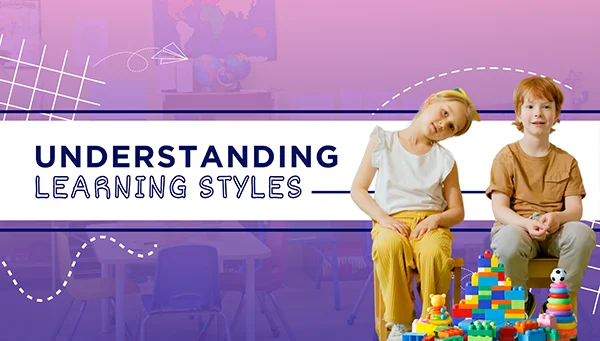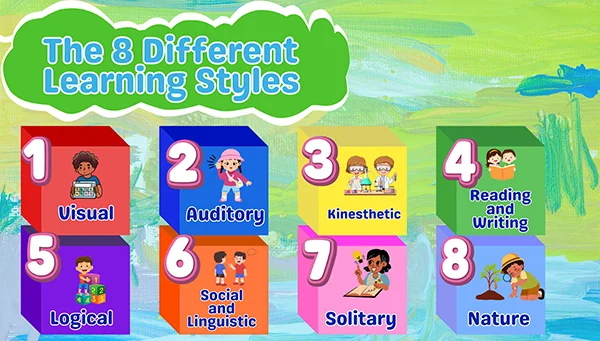

In education, learning styles pertain to a range of theories that aim to account for the differences in a person’s learning. In other words, they describe the diverse ways people absorb, process, and retain new information.
Parents play a central role in shaping their child’s academic performance through these learning styles. At the core of this achievement is understanding how each child learns best. Recognizing and supporting different learning styles can transform the educational experience, building confidence, engagement, and long-term growth.
The list of learning styles differs according to the school of thought you are listening to. Some stories online say there are four predominant learning styles, while others say these styles are more than that. In this discussion, you will learn what the consensus agrees upon, enumerating eight different learning styles. By the end of this piece, you will find out why these styles matter, plus practical tips for parents on how they can support their child’s chosen learning style.
The 8 Different Learning Styles

While no two children are exactly alike, researchers have identified eight common patterns that describe how students prefer to learn. These include:
Visual Learning Style
Visual learners rely on images, diagrams, and spatial understanding. They grasp concepts better when information is presented in charts, maps, or videos.
Auditory Learning Style
Auditory learners prefer listening; lectures, discussions, and verbal explanations enhance their comprehension. They retain knowledge through tone, rhythm, and storytelling.
Kinesthetic Learning Style
Kinesthetic learners learn by doing. Hands-on activities, experiments, and movement-based tasks keep them engaged and help them internalize lessons.
Reading and Writing Learning Style
The reading and writing learning style emphasizes text-based input and output. These learners thrive on note-taking, reading assignments, and written assessments.
Logical Learning Style
Logical learners excel in reasoning, patterns, and systems. They enjoy problem-solving, mathematics, and structured approaches that emphasize cause-and-effect relationships.
Social and Linguistic Learning Style
Social and linguistic learners benefit from group work, debates, and conversations. Collaboration and interaction stimulate their understanding, while communication strengthens memory.
Solitary Learning Style
In contrast, solitary learners prefer working alone. They are self-motivated, reflective, and comfortable with independent study, journaling, and personalized learning strategies.
Nature Learning Style
Finally, nature learners (naturalistic learners) connect best with the environment. They understand through observing nature, categorizing, and drawing parallels between the natural world and academic subjects. Outdoor learning, environmental projects, and real-world exploration enrich their education.
Recognizing which style resonates with a child doesn’t mean limiting them to one method. Instead, it’s about identifying what motivates and supports them most effectively and then blending multiple strategies for well-rounded learning.
Why Learning Styles Matter for Parents
Parents are often the first to notice patterns in how their child learns. Maybe your child
remembers song lyrics easily but struggles with written instructions, or perhaps they excel at building with blocks but lose interest during long lectures. By paying attention to these patterns, parents can:
- Support homework more effectively: Instead of pushing a child into methods that don’t suit them, parents can adapt study sessions to match learning strengths.
Boost confidence: Children thrive when they feel capable. Aligning study habits with learning preferences reduces frustration.
- Encourage independence: When students understand their learning style, they can advocate for themselves and adopt personalized strategies.
Improve school communication: Parents who understand their child’s style can collaborate better with teachers to ensure consistent support.
The Connection Between Learning Styles and Academic Success
When children learn in ways that feel natural, school becomes less of a struggle and more of an exploration. Studies show that aligning teaching methods with learning preferences can improve comprehension, retention, and test performance.
For example:
- A visual learner might perform better in math when given diagrams rather than abstract formulas.
- An auditory learner may understand history lessons more deeply when they participate in group discussions.
- A kinesthetic learner may grasp science concepts through lab experiments rather than reading a textbook.
By using strategies that align with natural tendencies, students engage more fully, which directly impacts grades and overall enthusiasm for learning. For instance, a visual learner might remember a math concept better if it’s color-coded on the board, while a kinesthetic learner could grasp it through a hands-on activity.
This focus on creating an environment tailored to student needs extends beyond just lesson plans and classroom activities. In fact, it can even apply to the clothes they wear. From French Toast school uniform sweaters for the colder months to comfortable pieces in warmer seasons, even something as simple as choosing classroom attire can play a role in creating consistency and comfort that supports different learning styles.
When students feel comfortable and focused, they are more likely to engage in ways that suit their preferred learning methods.

Practical Tips for Parents to Support Different Learning Styles
1. Teachers and Parents’ Collaboration
Teachers play a vital role in accommodating different learning styles, but parents can amplify these efforts by reinforcing strategies at home. Here’s how collaboration works best:
- Share observations: Parents should inform teachers of what works at home.
- Ask for variety: Encourage teachers to offer assignments in multiple formats—visual, written, and practical.
- Support classroom methods: If a teacher uses visual aids, mirror that approach in at-home study sessions.
By creating a partnership, parents and teachers can build consistency that strengthens a child’s academic foundation.
2. Building Lifelong Learning Habits
Understanding learning styles does more than improve grades. It builds lifelong skills. When children know how they learn best, they approach challenges with confidence. They become more self-aware, adaptable, and resilient—qualities that serve them well in higher education, careers, and personal growth.
Parents can reinforce this by encouraging reflection. Ask questions like:
- “What helped you remember that?”
- “Which part of studying felt easiest?”
- “What could you try differently next time?”
This not only helps children refine strategies but also teaches them the value of continuous improvement.
3. Creating a Supportive Home Environment
Beyond study techniques, the home environment plays a significant role in supporting learning styles. Parents can:
- Design quiet, organized spaces for visual and reading/writing learners.
- Provide background music or audio resources for auditory learners.
- Allow flexible seating or standing study stations for kinesthetic learners.
- Celebrate small wins and effort, not just outcomes, to reinforce confidence.
Consistency in the environment builds trust, making learning sessions smoother and more productive.
Every Child Is Unique
Recognizing their learning style is one of the most powerful ways parents can support academic success. By observing strengths, adapting strategies, and working closely with teachers, parents can transform learning into a positive, empowering experience.
Understanding learning styles doesn’t just help students get better grades—it helps them develop into confident, capable individuals who are prepared for lifelong learning. With patience, creativity, and support, parents can ensure their children not only succeed in school but also thrive in every stage of life.